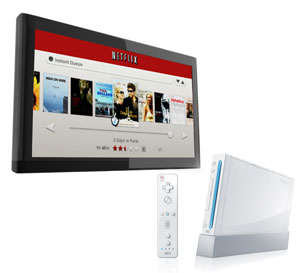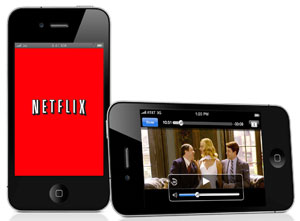Pages | 1 | 2 | 3 | 4 |
Netflix Review
Streaming App for Connected TVs and Other Devices
Streaming Setup
If you decide to take the plunge into the Netflix stream, you will need a few items before you go swimming.
First and foremost, you need an Internet connection and it should be as fast as you can afford. We are talking way beyond dial-up and to obtain a high quality stream, think beyond DSL.
You need to find an Internet Service Provider who can supply you with a downstream bandwidth speed of at least 5Mbps (that's megabits not megabytes per second).
If you are in a metropolitan area, many cable TV companies are offering these options. For example, AT&T's Uverse is called Internet Elite. Comcast labels theirs, XFINITY Internet. Time Warner, Road Runner Turbo. And there often are local providers who might offer better prices or faster speeds.
Whoever you choose, the cost can escalate quickly. Prices for lower end speeds around 5Mbps start at about $20 a month. Moving up to around 15 to 20Mbps can push your monthly bill to 45 or 50 dollars. (You should be able to find a better deal if you bundle your Internet service with phone or cable TV.)
Anyone who thinks the Internet is free has never had to pay the bill for the service. And I fully appreciate that $40 can be a chunk out of the monthly budget, but if you are serious about streaming movies, then go for the turbo-elite-xfinity speeds, ideally over 10Mbps.

Next, you will need a Netflix compatible device. You can find the current list on their site here. It includes gaming consoles, (PlayStation 3, Wii, and Xbox 360), streaming players, (like Apple TV and Roku, and others) , Blu-ray players, HTiBs and HDTVs, (too numerous to list), and mobile devices like the iPad.
Many of these devices have built-in Wi-Fi. If you decide to stream wirelessly, you will need a wireless router. Again, I suggest that you acquire the fastest one that you can. Right now, that would be an 802.11n variety.
We have three wireless routers in our facility and as much as I like the convenience of not running Ethernet cables from here to eternity, I still prefer the speed and reliability of a wired connection.
If you can pull it off without making your TV room look like a snake pit of wires, then I would recommend that you connect your router to your device with an Ethernet cable. Of course, some of those devices like an iPad are wireless only.
Once you have your Internet service and router set up, if you haven't subscribed to Netflix, that's the next step, which you do on the Netflix website. Then you will need to activate your device.
Usually devices like TVs and Blu-ray players will give you an activation code that you enter on the Netflix site. The activation process usually takes less than a minute. (Just make sure that your device is connected to the Internet when you activate it.)
You may stream on up to six unique devices. If you try to activate more than six, Netflix will ask you to deactivate one.
Once everything is communicating with each other, you need to select content that you wish to watch. Netflix uses a Queue system. Basically, you pick the movies or TV shows that you want to stream and add it to your list, called the Watch Instantly Queue.
When Netflix first started their streaming service, you had to build your Queue on the Netflix website. Now, the Netflix menus on many devices allow you to search titles and add them to your Queue directly.
One of the difficulties in detailing this step is that the Netflix interface is not the same on every device as you can see in these samples. And the menus and functions that you can perform tend to change over time.
For example, on some Sony products, the Netflix menu is still a basic listing of your Queue that you built on the Netflix site. On the other hand, some of the newer Samsung TVs have implemented a menu that suggests movies in genres like Comedy and Foreign.
In a whimsical twist, the Netflix menu in some LG devices lists movies in categories like Dysfunctional-Family or Feel-good Opposites Attract.
I hesitate to be too specific because I have seen many of these menus change fairly often. And I imagine that they will continue to be altered as this streaming service matures.
Streaming Quality
When streaming content, speed is important for two reasons. First, if your Internet connection is too slow, then the stream can stutter or pause while your system buffers more content. Stuttering definitely can ruin the flow of the movie.
Also, as Netflix is streaming a movie to you, it is constantly monitoring the speed of the connection and adjusting the data rate of the stream accordingly. The slower the speed, the less data is pushed down the pipe, which translates into poorer picture quality (PQ).

In addition, when Netflix began streaming, the only resolution choice was 480p, which is standard definition DVD quality. If you are streaming to a four inch smartphone screen, 480p will be just fine.
For those who prefer their movie viewing on an HDTV, Netflix now provides some of their titles in an HD (720p) stream. By my unofficial count, I see that Netflix offers 1718 titles that can be streamed instantly in HD. (This total is constantly changing.)
By comparison, Blu-ray DVDs are mastered in 1080p. So even under ideal situations, the HD stream will not look as good as a Blu-ray, especially on a big screen TV.
But if you are running the stream through your Blu-ray player or another device that will upscale the signal, the PQ should be acceptable until Netflix decides to supply 1080p streams.

Though Netflix hasn't committed to a 1080p timetable, competitors like Vudu are already offering 1080p streaming content.
One other quality area that Netflix is catching up on is audio. Until 2010, all the streams furnished stereo audio. Now, on select titles, Netflix is streaming the movie in 5.1 digital surround sound.
And one very recent addition, last week, Neil Hunt, Chief Product Officer for Netflix, gave an update on subtitles on content available to watch instantly from Netflix. He stated, "In the US, more than 3,500 TV episodes and movies have subtitles available, representing about 30% of viewing. More subtitles are being added every week, and we expect to get to 80% viewing coverage by the end of 2011 (with similar goals for Canada)."





![]() del.icio.us
del.icio.us
![]() Reddit
Reddit
![]() Google
Google

